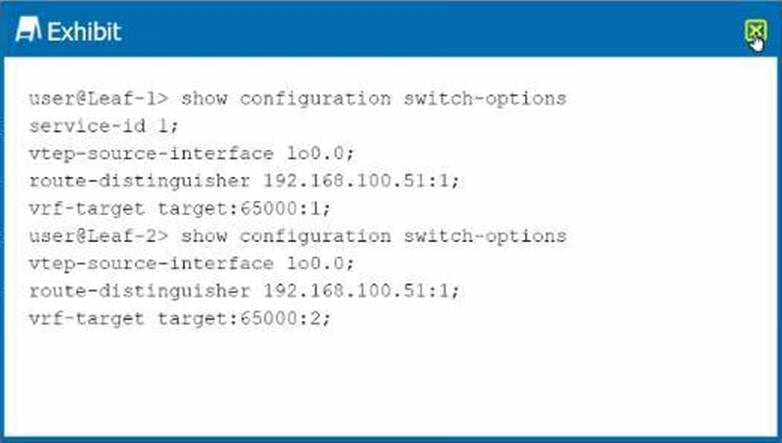Exhibit
Exhibit.

Connections between hosts connected to Leaf-1 and Leaf-2 are not working correctly.
A . Referring to the exhibit, which two configuration changes are required to solve the problem? (Choose two.)
B . Configure the set switch-options vtep-source-interface irb.0 parameter on Leaf-1.
C . Configure the set switch-options vrf-target target:65000:l parameteron Leaf-2.
D . Configure the set switch-options route-distinguisher i92.168.100.50:i parameter on Leaf-1.
E . Configure the set switch-options service-id 1 parameter on Leaf-2.
Answer: CE
Explanation:
Issue Analysis:
The problem in the exhibit suggests a mismatch in configuration parameters between Leaf-1 and Leaf-2, leading to communication issues between hosts connected to these leaf devices.
Configuration Mismatches:
Service-ID: Leaf-1 has service-id 1 configured, while Leaf-2 does not have this parameter. For consistency and proper operation, the service-id should be the same across both leaf devices. VRF Target: Leaf-1 is configured with vrf-target target:65000:1, while Leaf-2 is configured with vrf-target target:65000:2. To allow proper VRF import/export between the two leafs, these should match.
Corrective Actions:
C. Configure the set switch-options vrf-target target:65000:1 parameter on Leaf-2: This aligns the VRF targets between the two leaf devices, ensuring they can correctly import and export routes.
E. Configure the set switch-options service-id 1 parameter on Leaf-2: This ensures that both Leaf-1 and Leaf-2 use the same service ID, which is necessary for consistency in the EVPN-VXLAN setup. Data Center
Reference: Correct configuration of VRF targets and service IDs is critical in EVPN-VXLAN setups to ensure that routes and services are correctly shared and recognized between different devices in the network fabric.
Latest JN0-683 Dumps Valid Version with 65 Q&As
Latest And Valid Q&A | Instant Download | Once Fail, Full Refund

